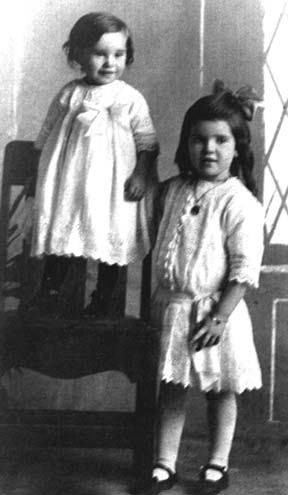What Is A Child?
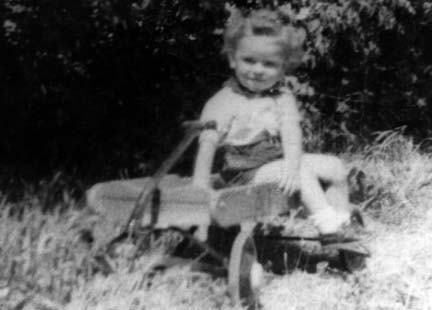
FTLComm - June 26, 1999
Being a kid was not always as easy as it looks in the picture on the left. I have a good recollection of my childhood and remember clothes that I thought were for girls and hair styles that seemed to fit in the same category.
But one always wonders just what is the society's role for the child. In this picture, I was my parent's only child, it was probably taken in 1947. I know that I was pretty much a "spoiled" child and appreciated the status. My parents had great expectations for me and I wondered considerably
But how different was my world at the middle of the century from the world of my uncles and aunt who started their life out at the beginning of the century. It was 1905, the year of the Boer War, that this picture on the right, was taken of Elizabeth Fisk posed for a picture of her second son Roy Lawrence, Elizabeth would have eleven children, one of whom died as a baby. She lived into her eighties, but as a result of a stroke in her sixties, her quality of life was greatly diminished for the later part of her life.
Roy would become a prosperous cattle breeder and farmer after having left home somewhat prematurely at s
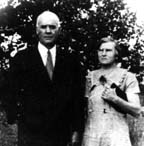 eventeen and had one son who still farms on the farm his father established.
Roy's life was turned upside down when his wife died as the result of a car crash
in the mid fifties and having a difficult time focusing his life, he died at the
age of fifty-six.
eventeen and had one son who still farms on the farm his father established.
Roy's life was turned upside down when his wife died as the result of a car crash
in the mid fifties and having a difficult time focusing his life, he died at the
age of fifty-six.Henry and Elizabeth lived North of Kelso for most of
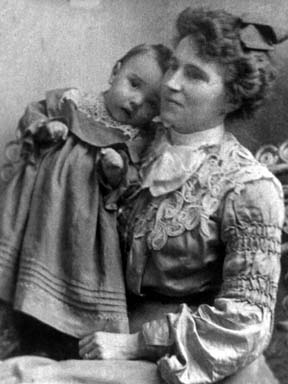
In the picture on the right, Roy is now about a year and a half, as he is seated for this picture with his older brother Edward in 1907. Edward farmed about a mile and a half South of his family's farm, North of Kelso, where, like his parents, he would raise a large family, three daughters and four sons with the youngest son still on the family farm.
I remember these pictures when I was a child myself and wondered just what was going on. Why did uncle Ed have pig tails and a dress and what's with uncle Roy's white frock?
Some sociologists have suggested that much of the confusion actually related to the image people had of what children were. They were thought of as merely miniature humans and of course, we have the French philosopher Jean Jacque Rousseau who imagined children as a "blank slate" ready for life to be written upon them to thank for the main stream developmental psychological thought of the time.
If you consider the turn of the century images and how these children are presented you might, like I did, suspect that the issue was considerable more complex. It seems to me that there was an extreme degree of androgynous thought as children were neither male nor female, but just children and since the care of them was by females, they tended all to be dressed and presented in a female manner. I think Ed resented that dress as much as I did having my blond hair curled and having to wear short pants.
It is likely that the turning point occurred with the children of these children. it was during their lives that society underwent the most dramatic changes. As these children reached adulthood two horrific world wars took place one right after
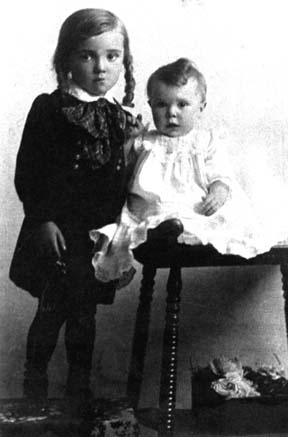
But let us consider Verna. This picture of this little two year old was taken in either 1910 or 1911. At least Ed and Roy did not have their picture taken with a hat.
It could be that the photographer was just unable to get his camera down to the right height because it was a monster of a wooden contraption and so to get the child into the picture she had to stand on a chair. The chair itself is an interesting thing its ornate Victorian design and very high back.
It was clear from the outset, that Verna would have the benefits of being the eldest daughter in this large family, as she became an outstanding cook, schooled in various skills with needle and thread, and had the ideal charming personality for the role. She is just as beautiful today living independently in Wawota and enjoys the freedom of driving her car.
Verna married a fine man, Jack McVicar's eldest son Carl who farmed at Vandura. They had a gentleman's family, a boy and a girl, the son still farms that land. Verna was not a typical farm wife of this era, but perhaps of her own. Up until the sixties she always had a "girl" during the summer and fall months to assist with the house hold chores and their farm always had a "hired man". This did not mean she did not participate in the agricultural business, for I remember her chickens and when Uncle Carl was away, I have seen her do the milking, as theirs was a mix farm raising purebred Shorthorns and a large amount of acreage in crop each year. It was not until the last fifteen years that Christmas or New Years was not spent by my family with Auntie Verna.
But the way of life changed so radically during her lifetimefrom servants to robots, from a husband who was

The year of the great war, 1914, was when Verna stood beside her brother Clarence towering above her on a chair. Equipped with locket, bracelet and bow in her hair, she is the picture of femininity, while Clarence is standing there in a dress.
Clarence also took up farming a few miles away from the Fisk family farm and had developed the reputation as a bit of a cantankerous fellow. I remember him as he was when I was five and six and he was to me, a miserable sarcastic fellow who's jokes were meant to be abusive, not funny and I felt he earned his nickname "Black". As a teenager I was once terribly embarrassed when needing to refer to him by his correct name, I discovered I didn't know what it was.
Clarence, proved quite impressively that it was not necessary to have my approval to be successful, as he was an excellent farmer, raised a family and left his farm to his son who is doing just fine. Like Ed he lived to be an old man and died of cancer. As far as I know his temperament was unchanged throughout his life.
These four children lived in almost a different era from the rest of their family. All of them witnessed the changes and adapted to them, but what they expected from life was different from those that would follow. Some other time I will tell you about them.
Will people look at our children's pictures at the end of the coming century and wonder what we were thinking and what sort of lives our children would endure because of the preconceptions of what we thought children are, or would become. Perhaps even more important are we any more aware of ourselves in our own time then was Henry and Elizabeth in their time?
